Quoting Blogdex, the purpose of the site is "to explore what it is about information, people, and their relationships that allows for this contagious media" [src]. I gave myself the task of trying to track a conversation, or I should say "follow" a conversation as terminology can be confusing as I learned playing with the site. The front page of the site has three main areas: the top navigation, the main content area, and the right "sidebar" area that is in turn broken down to various sections. (From a graphic-design perspective, the site is very clean and elegant.)
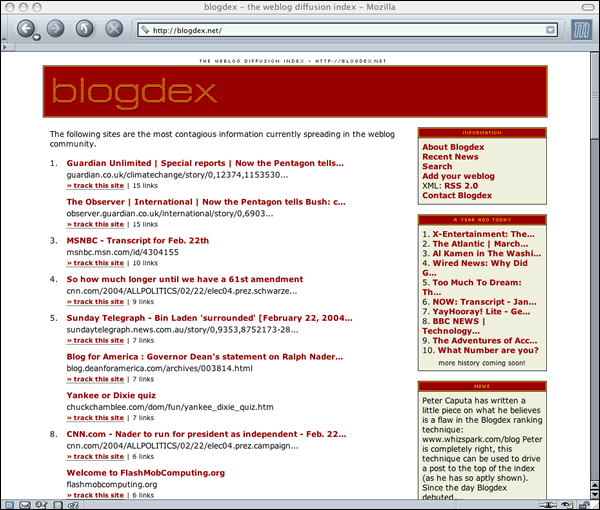
I was hoping for a search box so that I could enter a topic. But I didn't see one. In the main section of the front page is a list of sites, the "most contagious information currently spreading in the weblog community." Upon reading this description, I was unclear as to what that meant. I looked down at the list to see if I could figure out how the list was ranked (I guessed that they were ranked by the use of the word "most" and the numbering system at the left which implied a ranking with ties). After scanning the information contained in each list item, I realized that they were ranked by the number of links. I assumed that this meant the number of "inbound" links to the article, but wasn't sure.
As expected, clicking the headline to each item in the list, brought up the linked page in the same browser window. Each item also had a link saying "track this site." I was curious as to what would happen. I imagined that perhaps it would ask me to login before I could track anything. Or maybe it would send a cookie that would somehow let me track a site. To my surprise, that link led me to another page that had a list of blog sites, grouped by date and sorted from most recent to oldest on a given day (I am guessing that these are EST).
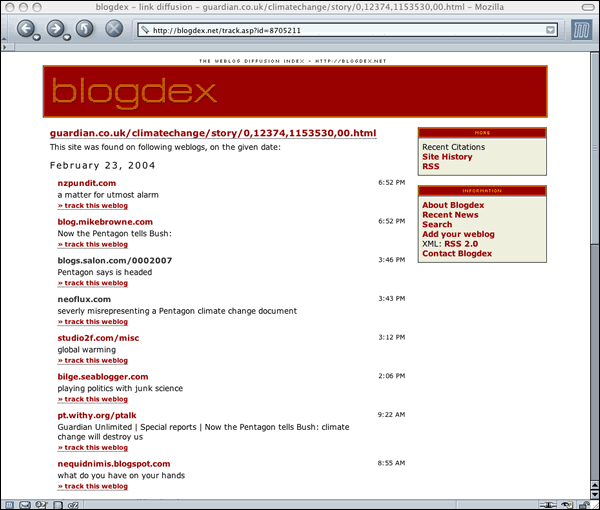
I should note that while the "track" language was confusing, once I realized what it did, it was easy to remember. In fact, tracking a site (using Blogdex's terminology) is one way that I could follow a conversation. I couldn't see who had read whom, but I could at least see the order in which people linked to the orignal story.
So, I guessed that I knew right away what the "track this weblog" would do when I clicked on it. I was wrong. To be more accurate, I should say that I was wrong the second time I ran through it (I had tried this several hours previous to writing this up but forgot what happened). I am glad that I double-checked. I expected a list of blog posts sorted by day and by time. Instead I saw the following:
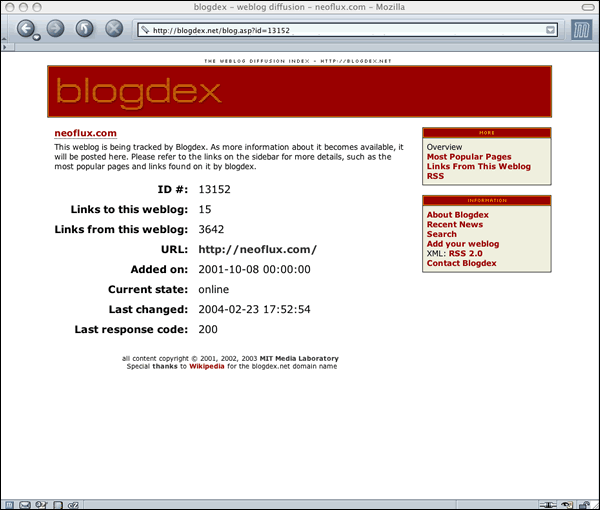
For the purposes of my task, the only relevant data were the "last changed" date and possibly the "links to this weblog." I was also disappointed that I couldn't click on the "links" to see another list of blogs.
Then, I noticed that in the right sidebar under information was a link to "search." Then I remembered that "information" had moved down one in the sections in the side-bar. I went back to the front page by clicking the back button. Sure enough, there was a search link, two down from the "About Blogdex" link.
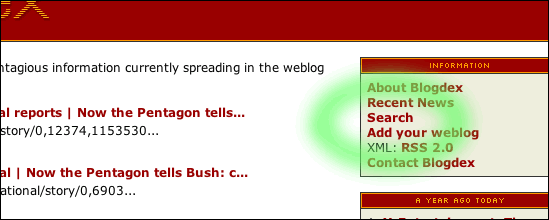
I read the instructions and was confused right away. I saw the phrase "two techniques are available," which on the surface was confirmed by the two search boxes. But then it refered to URL search vs. Text search. I saw the that the first box was for URLs, but they second box was followed by a track button... which lead me to see that the second box was also for URLs! But, it was for "tracking" rather than "searching," according to the button. So what was "text" referring to in the instructions? I finally noticed that the first box was followed by a drop down box. I then realized that the other option would probably say "text." And it did.

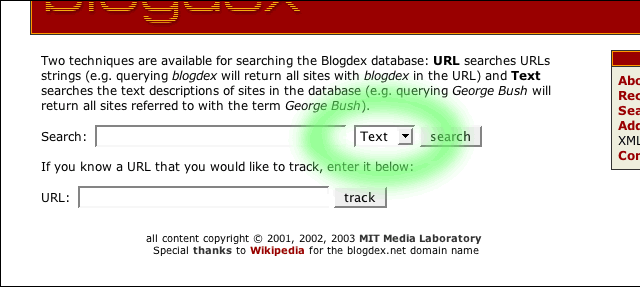
Twenty five results were returned by my search for "visualization" (I had to scroll down to find that out). And after a few alternate searches, I realized that blogdex only returned 25 items on a text search (I tried "basketball" and "bush" also). I didn't try the url search. I was not sure how the results were ranked. There was not the same data about linkages that I saw on the front page. By "tracking" a site, I was able to get a general sense of the conversation based on how many people linked, in what order, on what day. This is useful, but not really good enough for my task.
The creator of the service is trying to show a list of the "fastest spreading ideas," which are displayed on the front page of the site. It wasn't clear that this is what the front page really showed. Furthermore, rather than get a sense of the "spread" of ideas, I was only to able to see how many people linked to the primary news story or article, rather than how the ideas spread outward.
Strong points
- I liked the use of the term "weblog" rather than "blog." But, it's also not what's started to being used in mainstream media (so this could be a weak point as well).
- Although not relevant to my task, the page for adding a personal blog was great. It didn't require the user to have to jump through a lot of hoops. It also provided a nice cue to indicate what to put in what text box:
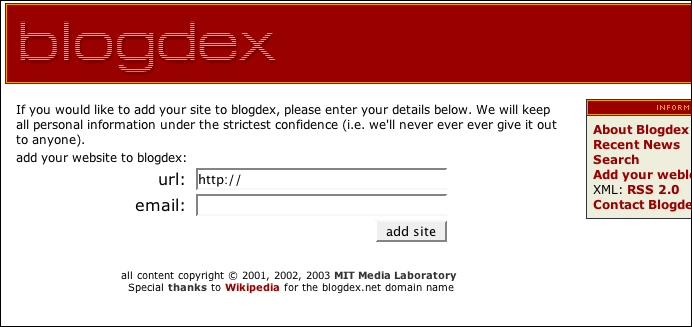
- "Year ago today" feature was really interesting. I can see this being a nice bonus feature.
- Clean, simple design; the author claimed to want to follow the Google model "Do one thing, and do it right." Overall, I think he succeeded...
Weak points
- ...(continued from above) but I don't think that the "one thing" really matched his stated purpose nor was particularly compelling. I am trying to envision how many tasks it could really support.
- Overall, terminology was confusing, or results didn't match my expectations;
- Search should have been more prominent, even if not the primary purpose of the site;
- Search page instructions were lengthy and confusing;
- The "next" and "previous" links at the bottom of the front page didn't give me any indication of how many pages there would be to click through;
- Sometimes, I got confused: I clicked on the name of a blog expecting the "track this weblog" page;
- I wasn't sure what "recent news" would link to (under "Information" in the sidebar). I thought it might be news articles (or blogs?) sorted by date. It turns out that it is the author's blog.
- I am fine with the side bar contents changing between pages, but it was confusing when items that were consistent across pages were not in the same place. On the other hand, I can see how you'd want the most context-sensitive stuff to be at the top. Tricky problem.